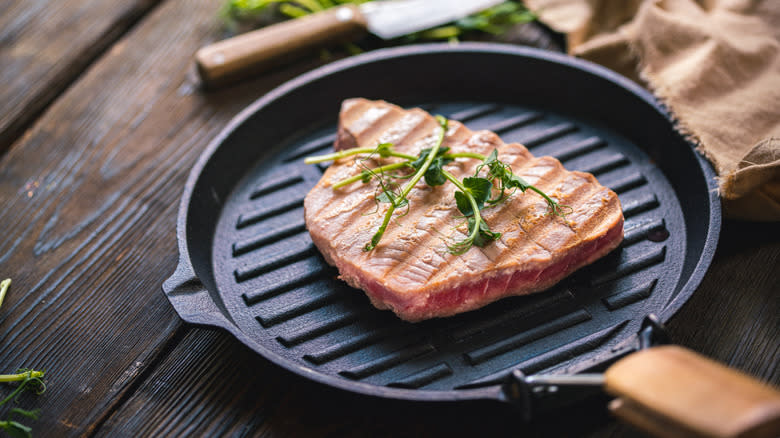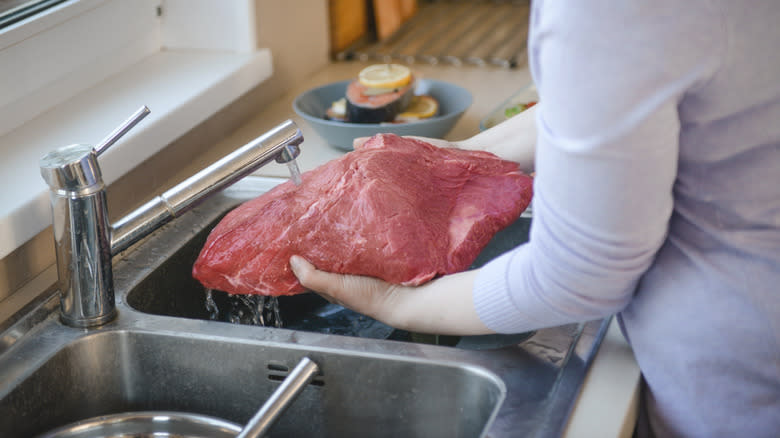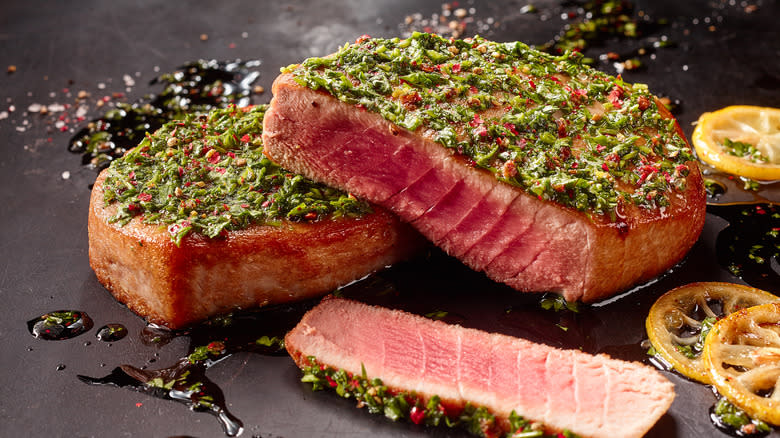Do Tuna Steaks Need To Be Washed Before Cooking?

If you often cook fish at home, you're probably no stranger to bringing some big, deep red tuna steaks home. You remove them from the packaging and give them a good rinse in cold water before drying them with paper towels and, say, searing your tuna with olives and capers. You were likely taught to do this, with the idea that it's the best way to clean raw meat. In fact, washing tuna steaks (or any animal protein, really) prior to cooking is a terrible idea that does nothing in terms of removing harmful bacteria from the meat's surface. What actually kills the bacteria that causes food poisoning is cooking the food to a safe internal temperature.
What rinsing off raw meat will do -- and quite effectively, at that -- is spread any bacteria present all over your prep area. It can travel as far as a three-foot radius around your sink (which, if you wash dishes by hand, has pretty grim implications for any plates or utensils sitting in an adjoining rack). Cold water can't sanitize anything, but it's super-great at cross-contamination as it creates tiny droplets that act as aerial bacteria taxis. It makes you wonder why anyone still washes meat before cooking it.
Read more: 12 Underrated Types Of Fish You Should Try At Least Once
Washing Meat Is An Ancient Tradition

Back before commercial meat production, it was a good idea to clean blood, dirt, and various other nasty substances from raw, unprocessed meat. Clearly, this became a tradition that was passed down. Nowadays, not only has that process almost always already happened before we purchased the stuff (provided you're getting meat or fish from a store or butcher), the act of washing raw meat can increase the risk of bacterial infection. However, in some cultures, the cleansing of meat is far more ancient than what our ancestors were doing one or two hundred years ago.
In the Jewish tradition, it is necessary to remove as much blood as possible from animal flesh. There are strict rules for slaughterhouses to follow in order to produce what is known as kosher meat -- and even then, a final act known as kashering is required, in which the meat is rinsed with cold water and coated in coarse salt. This process often, but not always, occurs in the slaughterhouse, because there must be no visible blood on any food considered kosher. If you are kashering your meat at home, make sure your prep area is thoroughly cleaned and sanitized afterward.
Follow Cooking Temperature Guidelines Or Assume The Consequent Risks

So, unless you're following a religious tradition, skip washing red meat, poultry, and fish -- and while you're at it, don't bother "sanitizing" them in a salt water or vinegar solution, as that won't cut it either. Instead, cook the food according to the USDA's safe minimum internal temperature suggestions, which for tuna is an internal temperature of 145 degrees Fahrenheit. Of course, people can (and often do) eat raw, sushi-grade tuna or turn it into a tartare with an acid like lemon or lime juice and other ingredients. Just bear in mind that with other kinds of tuna, salmonella is not your only concern.
According to Healthline, tuna fish are often infected with several different kinds of parasites which can cause all kinds of gastrointestinal issues for the unwary consumer. Properly cooking the fish will kill these parasites off; however, if you're really into making tuna tartare, freezing it thoroughly should also do the job. (Any fish labeled sushi-grade has already been frozen for just this purpose.) So, please make that herb-crusted ahi tuna; just make sure you know where it came from, and for goodness' sake, skip the rinse.
Read the original article on Daily Meal.

